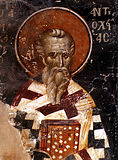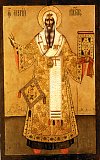

| Previous day | Next day |
| Old Style
February 12
|
Thursday |
New Style
February 25
|
| Fast-free Week. Tone 4. | No fast.
|
![]() Appearance of the Iveron Icon of the Most Holy Theotokos (Mt. Athos) (9th c.).
Appearance of the Iveron Icon of the Most Holy Theotokos (Mt. Athos) (9th c.). ![]() St. Meletius, archbishop of Antioch (381).
St. Meletius, archbishop of Antioch (381). ![]() St. Alexis, metropolitan of Moscow (1378). St. Meletius, archbishop of Kharkov (1840).
St. Alexis, metropolitan of Moscow (1378). St. Meletius, archbishop of Kharkov (1840).
St. Mary, nun (who was called Marinus), and her father, St. Eugene, monk, of Alexandria (6th c.) St. Anthony II, patriarch of Constantinople (895). St. Meletius of Lardos, founder of Ypseni Monastery (late 19th c.). St. Bassian, founder of Ryabovsk Monastery (Uglich) (1509). Hieromartyr Urbanus, pope of Rome (223-230).
St. Ethilwald of Lindisfarne (740). St. Prochorus of Georgia, builder of Holy Cross Monastery near Jerusalem (1066). New Monk-martyrs Luke (Mukhaidze) (1277) and Nicholas (Dvali) (1314), of Jerusalem, and the holy fathers of the Georgian monasteries in Jerusalem. New Martyr Christos the Gardener, of Albania, at Constantinople (1748).
Repose of the cave-dweller Anastasia (Logacheva) of Ardatov (1875).
Thoughts for Each Day of the Year
According to the Daily Church Readings from the Word of God
By St. Theophan the Recluse

Thursday. [I John 1:8–2:6; Mark 13:31–14:2]
What the Apostle directed us towards yesterday, the Gospel now suggests directly to us: Take ye heed, watch and pray: for ye know not when the time.… Watch ye therefore ... lest coming suddenly he find you sleeping (Mark 13:33, 35–6). It is necessary to wait, and every instant to keep in mind that the Lord is about to appear and shine like lightning from one end of the universe to the other. It is thought by some that it is possible to replace this waiting upon the Lord with waiting for death. This is good, or at least this should be done. But awaiting the coming of the Lord is one thing, and awaiting death another. They lead to different thoughts, and to different feelings born under the impact of these different thoughts. Await the day of the Lord, when all will end in an irrevocable determination. After our death, time will still continue in an undecided state; but the day of the Lord will assign everything for eternal ages, and it will be sealed, so you cannot expect any changes. “I have been waiting,” you say. So wait longer, and continue to wait. “But this,” you say, “will poison all my joys.” It will not poison your joys—it will only drive away from your everyday life those joys that are illegitimately so-called. You will still rejoice, only in the Lord. It is possible to wait for the Lord with this joy; and if the Lord finds you in this joy, He will not call you to account, but will praise you.
Monday (36th). [III John 1:1–14; Luke 19:29–40, 22:7–39]
What does it mean to walk in truth (III John 1:4)? It means accepting truth in your heart, abiding in such thoughts and feelings as the truth requires. Thus, it is the truth that God is everywhere and sees everything. He who accepts this truth with his heart and begins to keep himself both inwardly and outwardly as if God Himself were before him and were seeing everything within him, is walking in this truth. It is the truth that God contains all, and that without Him we cannot do anything successfully. He who accepts this with his heart, and turns in prayer in whatever he does for help to God, accepting whatever happens to him as being from the hand of the Lord—is walking in this truth. It is the truth that death could steal us away at any hour, and after death immediately comes the judgement. He who accepts this truth with his heart, and begins to live as if he were about to die this minute and appear before the judgement of God, is walking in this truth. So it is concerning every other truth.
Articles
 Venerable Mary (who was called Marinus), and her father at AlexandriaSaint Mary and her father Eugene lived at the beginning of the sixth century in Bithynia (northwestern Asia Minor). |
 St. Anthony the Patriarch of ConstantinopleSaint Anthony, Patriarch of Constantinople, was a native of Asia, but lived in Constantinople from his youth. |
 St. Bassian of UglichSaint Bassian came to the Protection monastery when he was thirty-three years of age, and was soon tonsured by Saint Paisius. |








